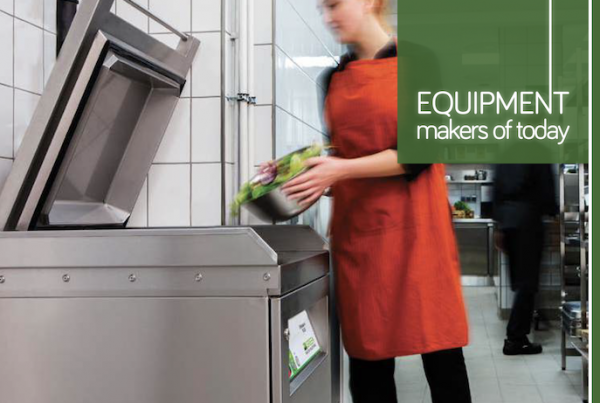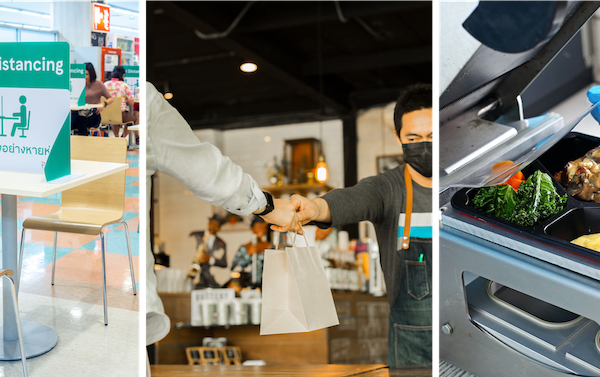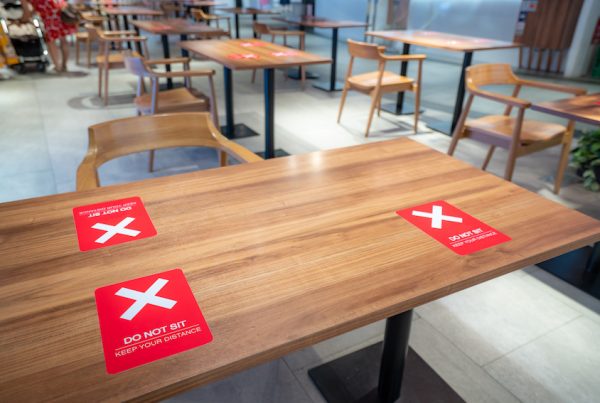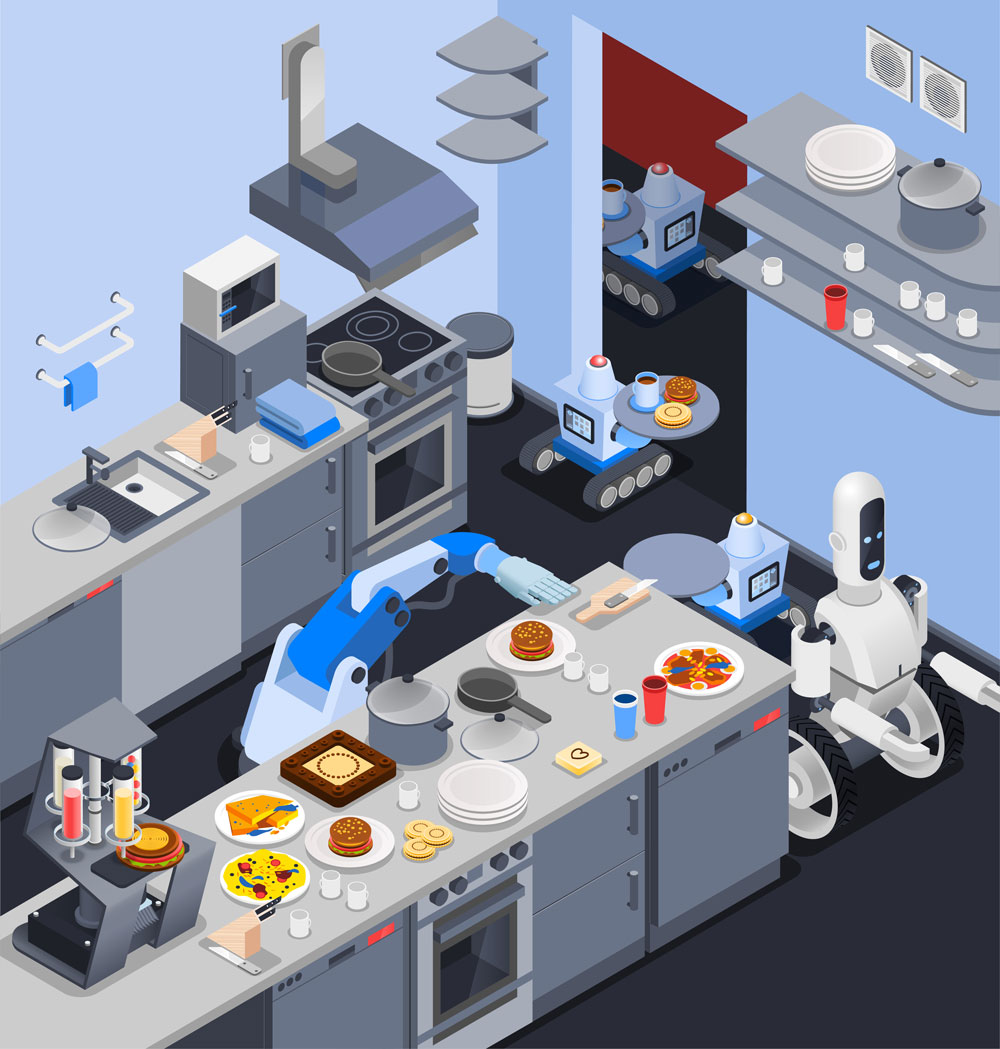
We have just entered a new decade and 2020 continues to show technology changing the way commercial kitchens operate and improve food quality as well as outcomes in restaurants. With each passing day, impressive technology is being developed, improved on and perfected to automate daily kitchen processes. In fact, with the emergence of the Internet of Things (IoT), a medium that connects anyone and anything to the World Wide Web, inanimate objects like fridges, ovens, griddles and grillers can now communicate and share high levels of digital intelligence data between the user and other inanimate objects, without any human intervention. Akin to having “a mind of their own” in form, these inanimate object or machines are able to relieve restaurant staff off some tiring, mundane kitchen work that are often repetitive, labour-intensive and overwhelming.
In a business environment that is more competitive than ever before, restaurants are under increasing pressure to deliver much more than just a great meal. Foodservice businesses have to find ways to trim costs without sacrificing the quality of the food or the customer experience. For this reason, many restaurant operators have embraced technology, automation and even robotics to some extend, to gain a firm handle on daily kitchen operations, inventory, resource and energy management, speed and accuracy of service, quality and safety of food, wastage prevention and, equipment maintenance.
INSIGHTS FOR THE FUTURE
With various technological advancements available in the new decade, it may be helpful to know where restaurant operators should be investing in, in order to bring their commercial kitchen into the future. Let’s take a look at some insights from a new 10-year outlook report titled “Restaurant Industry 2030: Actionable Insights for the Future,” prepared by the National Restaurant Association’s together with American Express and Nestlé Professional. The report examines the key indicators shaping the future of the foodservice industry, identifies the most and least likely developments in the upcoming decades, and considers possible disrupters outside the industry that could transform it. For the foodservice equipment sector, the report further forecasts that sustainability will become increasingly importance, the workforce will grow grayer, kitchen equipment will grow smarter, and delivery will continue to be a major factor from this decade onwards.

The reports projects that by 2030:
• Back-of-house operations will become more fully automated as costs fall and flexible, reprogrammable robot systems grow more sophisticated.
• The restaurant of the future will be smaller with more automated kitchen equipment and the typical kitchen layout may change.
• Artificial intelligence with knowledge of cooking techniques, food chemistry, recipes, and alcohol could produce unexpected new culinary and beverage experiences.
• Through technological advancements, more restaurants will be designed to reduce use of energy and water and minimize waste.
By deconstructing the possible trends and innovations of the upcoming decades, both large and small-restaurant operators will be able to anticipate their greatest challenges in this already highly competitive foodservice industry.
TECHNOLOGY & AUTOMATION: FUTURE-PROOF KITCHEN FEATURES
Technology together with automation can make processes more efficient as well as decrease kitchen costs. Although some of this technology comes with a hefty price tag, new developments and improvements to old ones are making kitchen systems more accessible and affordable. This is why we can expect that more restaurants will continue to jump on the automation train as the foodservice industry continues to mature and specialise. To keep your commercial kitchen ahead of the curve, here are 5 future-proof kitchen automation features to invest in:
Integrated Kitchen
First and foremost, you will need a back-of-house solution that can integrate with all the devices in your restaurant. Its difficult to create a well-connected restaurant with technology that does not communicate with one another. The good news is, with the Internet of Things, you can find kitchen automation which includes software that connects both the front- and back-of-house, as well as offers a multitude of integration options. Having kitchen automation software with integration partners can protect your investment should you ever need to swap the software in your restaurant.
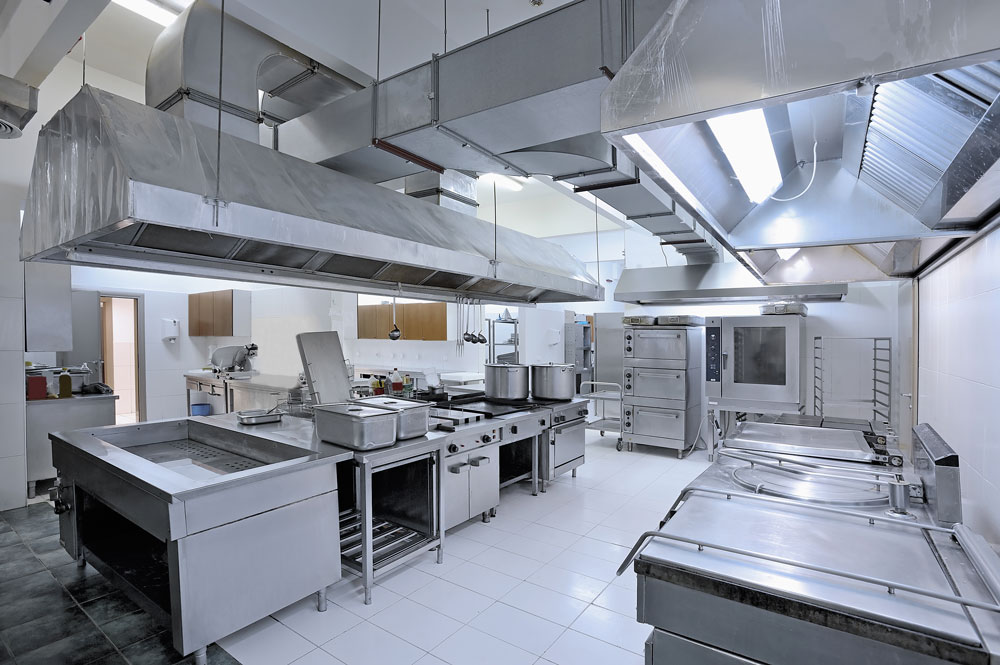
Kitchen Data
As a restaurant operator, you will no doubt want to create a smarter, more efficient, and profitable restaurant. This is where kitchen data becomes highly essential. A number of Kitchen Display Systems (KDS) are now starting to gather data from every stage of the guest’s dining journey, creating a more personalized experience from the first contact until they leave your restaurant. With this data in hand, restaurant operators can use it to create marketing campaigns and identify bottlenecks. Real-time data gives operators and owners a complete scope of kitchen activity so that they can make critical business decisions immediately.
Capacity Management
With an increased demand for off-premise dining and delivery options, this feature is imperative for blending the dual streams of traffic (in-store and off-premise). A KDS with a quoting manager will pace the orders based on real-time activity in the restaurant instead of just volume of order. In turn, the off-premise diner is provided an accurate quote time, and your kitchen isn’t stressed. When traffic picks up in the kitchen, quoting to delivery partners and customers take all restaurant traffic into account. This way, guests receive their order at the expected time.

Automated SMS Texting
If your restaurant has a Kitchen Display System with a good quoting software, you may be able to send out automated SMS texts to off-premise diners, to alert them of the exact stage of their order. For example, the Domino’s Tracker keeps customers up to date on their order’s status from when the order is prepared to when it is on its way. Some KDS software also offers SMS capability to send texts from the kitchen to the servers and bussers.
Mobile Capability
A number of kitchen automation systems offer a business intelligence app for restaurant owners. Through the app, operators can set alerts for when a particular metric falls below standards. For example, if an order sits in the delivery window for more than three minutes, the operator will be notified via the app. Users can also gain a quick glimpse of restaurant activity such as cook times to seating economy.
AUTOMATED KITCHEN APPLIANCES
Apart from automated kitchen features, there are a number of automated kitchen appliances that can bring your kitchen into the new decade. Listed below are some examples of this.
Frying Made Easy
Traditionally a hot, greasy, repetitive, and generally dangerous job, frying has now become a lot easier, efficient, energy- and cost-saving as well as safer! Automated controls and cooking processes cut labor and eliminate safety issues while boosting the quality and consistency of fried foods.
Introduction of fryers with built-in oil filtration throughout the day has meant improved oil quality and food taste as well as extended oil life. Some new fryers use 40% less oil than older models, with automatic top off and filtering.Taking automation even further are fryers with an integrated oil quality measuring system that eliminates subjective manual testing. Welbilt Frymaster’s oil conserving range of fryers not only uses 40% less oil, but is also equipped with the full-featured SMART4U® OCF30 3000 Controller that can monitor and report on oil level, oil life, cook counts, and fryer performance.
Heating Food Up: Commercial Griddles
The double-sided grill has come a long way since McDonald’s first used it in the ’60s. Welbilt’s new Garland Xpress grill, for example, can cook items up to 2 inches thick between its grill plates and has icon-based touchscreen controls so that operators can preset the cooking temperature and time for each menu item. The platens lower and lift automatically when food is done. The grill’s rapid recovery and rapid pre-heat features also saves approximately 24% energy by allowing the griddle to cool between peak periods.
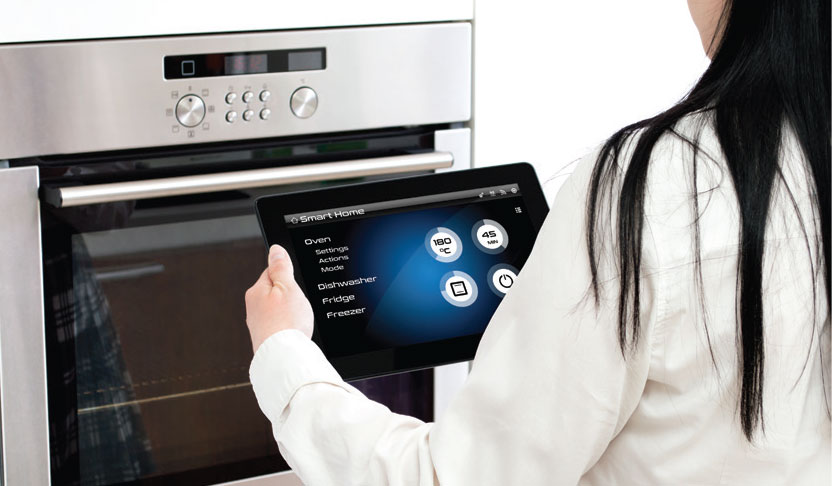
The Rise Of Smart Combi Ovens
Combi ovens are another big labour-and time-saver with its three-in-one cooking function using convected heat, steam, or a combination of both. Combi ovens make it possible for chefs to perform an impressive array of functions within a single piece of equipment. Not only does it cook food quickly, a combi oven also takes all monitoring and checking work off the kitchen staff’s hands. It adjusts temperature, moisture and cooking time settings on its own, monitors the food’s browning and degree of doneness, as well as save chefs the trouble of repeatedly turning pan-fried dishes.
A great example is Rational’s SelfCookingCenter®, the world’s first truly intelligent oven. Rational’s smart combi oven line now offers a compact-size XS model available in addition to larger sizes in electric and gas-powered versions, all the way up to a roll-in model. All have an integrated fresh-steam generator; built-in cooking intelligence that recognizes the size and quantity of food items and calculates the best cooking method and time; and a labor-saving self-cleaning and descaling feature, which can be done unsupervised overnight.
Many combi oven makers include automatic cleaning cycles as an option on their units. Also automated with a self-cleaning feature is a new Alto-Shaam rotisserie oven. The patent-pending water jet design can handle heavy grease collection while minimizing water use. During cooking, the unit automatically pumps grease into a collection container for safe handling and disposal.
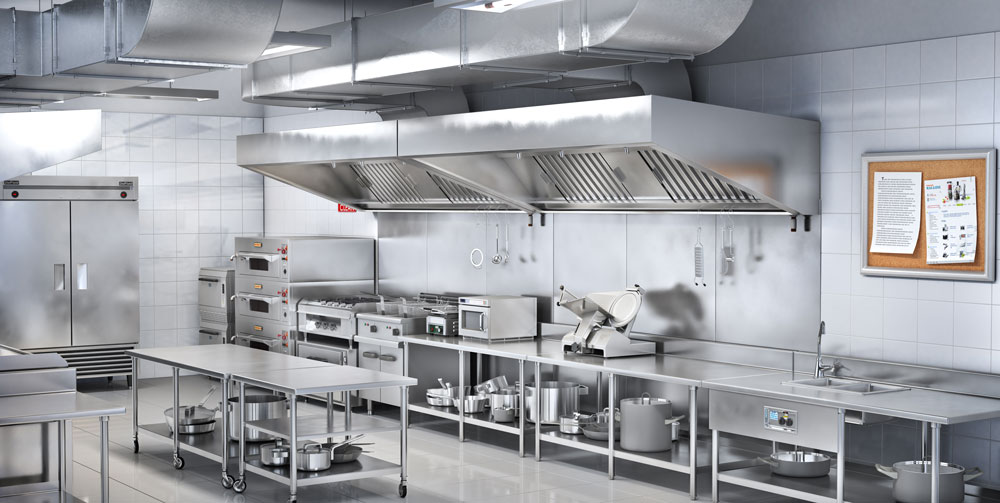
HVAC Usage And Temperature Tracking
Energy costs in the food services sector are three times higher per square foot in comparison with other industries. But heating, ventilation and air conditioning (HVAC) systems are a particularly hefty energy and financial drain.Therefore, it is important to install a system that can monitor HVAC energy usage, as well as provide real-time alerts when problems arise. Suitable for hoods and ventilated ceilings in restaurants, Halton’s M.A.R.V.E.L. Intelligent Demand Controlled Ventilation system which monitors by zone or kitchen block reduces exhaust airflow rates by up to 64%. For example, in a hood ventilation system, M.A.R.V.E.L. can adjust the exhaust airflow hood by hood and in a fully independent way. If just one cooking range is operating, only the airflow for that hood concerned will be automatically adjusted. The other hoods will continue to operate at a low flow rate. It works the same way with the zones of a ventilated ceiling. The Halton’s M.A.R.V.E.L. system also regulates the exhaust fan speed to keep power consumption at a bare minimum, resulting in massive savings on air conditioning and on the electrical consumption of the fans.
Keeping It Cool
The refrigeration unit is one of the most important equipments in an F&B business because this is where all the vital stocks are kept. With automation and technology, a refrigerator can become a separate appliance – each shelf, drawer, and freezer section can be monitored and thermostatically controlled independently. “Incompatible” foods, such as cakes and pies, can be stored and cooled/frozen at different levels in the same appliance. The system can determine spoilage time, when food is supposed to be used by, if its chemical makeup changes (such as a marinade), and if pathogens are present. Some Smart refrigerators can even monitor inventory levels, which will then send alerts to the Chef or kitchen manager to order more stock when it runs low.
For more affordable options, restauranters can also install automated temperature-monitoring devices or wireless thermometers to ensure that the refrigerators are operating at optimum temperatures and the integrity of food items are kept intact. The Pine Garden Bakery and Empire State Restaurant in Singapore have both leveraged on these automated refrigeration monitoring devices.
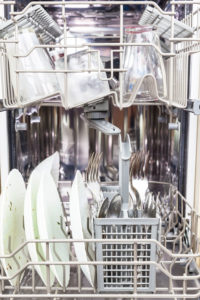 Warewashing Power
Warewashing Power
Warewashing may be the most labour-intensive work for foodservice workers than any other area of a foodservice facility, therefore this work is an obvious candidate for automation. With Winterhalter’s UC Series Undercounter Dishwasher, kitchen staff no longer have to manually wash any dishes, glasses, cups, bowls and utensils but simply pre-scrape off any food or beverage leftovers on the wares before loading them into the dishwasher and letting the diswasher do the job. The UC Series from Winterhalter impresses with its intuitive controls, economical operation and excellent cost-effectiveness. Its mission is sparkling glasses, clean dishes, and impeccable cutlery.
ROBOTICS HAVE ARRIVED
Imagine being served by a robot or watching one prepare your meal in a restaurant? While to many, this may be a unique experience as robots are still unfamiliar rarities, it is a foregone conclusion that these machines are here to stay and will eventually become a huge part of the restaurant and foodservice industry. A few examples of robots that are already working in the restaurant kitchen are:
• Three robots are employed by the American delivery service Zume Pizza to prepare pizza bases (spread sauces on and put them into the oven).
• Robots Kona and Koya cook four different ramen dishes in a shopping mall in Shanghai.
• Spyce, a robotic-powered restaurant in Boston, Massachusets cooks complex meals in under three minutes. A robotic chef with seven magnetically heated woks and finely tuned temperature and time sensors tosses and sears the ingredients and dumps them into compostable bowls.
• CaliBurger, a burger restaurant in California, USA, employs Flippy, a burger-flipping robot.
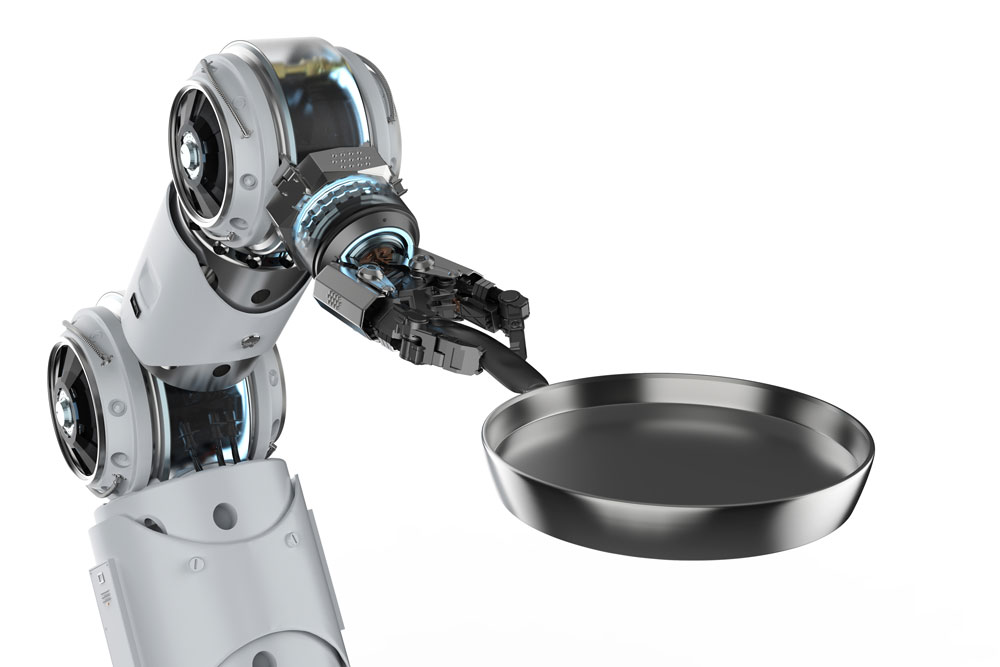
• At Henn-na, a restaurarant outside Nagasaki, Japan, food is prepared by a line of humanoid robot chefs that shake cocktail drinks, fry donuts, shoot out perfectly portioned salads, and cook pancakes with spatula-like arms.
• Sally, a self-contained salad-making robot from Chowbotics that can assemble salads using up to 21 pre-chopped ingredients that are loaded into its hoppers daily.
• Haidilao, Beijing’s first robot-aided hotpot restaurant employs robots that will take orders, prepare and deliver raw meat and fresh vegetables to customers to plop into soups prepared at their tables.
• Picnic, a Seattle-based technology company unveilled a Pizza-making robot in January 2020 that is capable of making up to 300 12-inch pizzas, all with customized toppings, per hour.
• Moley, a UK-based robotics company has created the world’s first robotic kitchen. Featuring an advanced, fully functional robot integrated into a beautifully designed, professional kitchen, it cooks with the skill and flair of a master chef.
• Wilkinson Baking Company created a bread-making robot that does the work of a full bakery. Using a mix of dry ingredients, the machine blends, prepares and cooks the dough and serves customers with freshly-made bread on site.
As the industry continues to evolve, so will kitchen technology. By streamlining commercial kitchens with automation and robotics, many day-to-day pressures that kitchen staff experience can be eliminated. Kitchen automation is the vital piece of the puzzle that will help contribute to creating a smarter, more efficient restaurant that keeps guests happy and builds loyalty. Restaurant operators that invest in the right kitchen technologies will be rewarded with vitality and growth, not only in the next year, but well into the future.
href="#" data-color-override="false" data-hover-color-override="false" data-hover-text-color-override="#fff">Button Text






